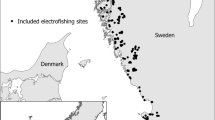Abstract
Over the past 25 years it has become apparent that European eel recruitment has declined despite increased awareness and the development of protective legislation at local, national and European levels. A number of factors in both the freshwater and marine environment have been identified as potentially causing the decline, but there is little evidence how they specifically affect eel populations. There has been very little monitoring of European eel populations and therefore few robust data sets to allow long-term analysis. Eels were monitored at three sites in the Thames catchment between 2005 and 2009. At one site (River Roding) the catch per unit effort declined significantly after 2007, whilst at the other sites (River Thames and River Darent) catches were low throughout the period of the survey. Comparison of eel abundances at the River Darent caught in the present study with those caught in the mid 1980s would indicate that recruitment has declined by over 99%. The study highlights the lack of data relating to eel recruitment in the River Thames, and the UK as a whole, and supports both improved monitoring and the adoption of a precautionary approach in their management, irrespective of the causal factors for the decline.


Similar content being viewed by others
References
Bark, A., B. Williams & B. Knights, 2007. Current status and temporal trends in stocks of European eel in England and Wales. ICES, Journal of Marine Science 64: 1368–1378.
Bevacqua, D., P. Melià, A. J. Crivelli, M. Gatto & G. A. De Leo, 2007. Multi-objective assessment of conservation measures for the European eel (Anguilla anguilla): an application to the Carmargue lagoons. ICES Journal of Marine Science 64: 1483–1490.
Bonhommeau, S., E. Chassot & E. Rivot, 2008a. Fluctuations in European eel (Anguilla anguilla) recruitment resulting from environmental changes in the Sargasso Sea. Fisheries Oceanography 17: 32–44.
Bonhommeau, S., E. Chassot, B. Planque, A. H. Knap, O. Le Pape & E. Rivot, 2008b. Impact of climate on eel populations of the Northern Hemisphere. Marine Ecology progress Series 373: 71–80.
Castonguay, M., P. V. Hodson, C. Moriarty, K. F. Drinkwater & T. Jessop, 1994. Is there a role of ocean environment in American and European eel decline? Fisheries Oceanography 3: 197–203.
Chadwick, S., B. Knights, J. L. Thorley & A. Bark, 2007. A long-term study of population characteristics and downstream migrations of the European eel Anguilla anguilla (L.) and the effects of a migration barrier in the Girnock Burn, north-east Scotland. Journal of Fish Biology 70: 1535–1553.
DEFRA, 2009 Eel management plans for the United Kingdom: Thames River Basin District.
Dekker, W., 2003. Did lack of spawners cause the collapse of the European eel, Anguilla anguilla? Fisheries Management and Ecology 10: 365–376.
Environment Agency, 2009. Sampling eel populations in rivers. Operational instruction 778_06.
FAO, 1995. Code of Conduct for Responsible Fisheries. FAO, Rome.
Feunteun, E., 2002. Management and restoration of European eel population (Anguilla anguilla): an impossible bargain. Ecological Engineering 18: 575–591.
Gollock, M. J., C. R. Kennedy & J. A. Brown, 2005. European eels Anguilla anguilla (L.), infected with Anguillicola crassus exhibit a more pronounced stress response to severe hypoxia than uninfected eels. Journal of Fish Diseases 28: 429–436.
ICES, 2008. International Council for the Exploration of the Sea. Report of the ICES/EIFAC Working Group on Eels. ICES CM 2008/ACFM:15.
IUCN, 2009. IUCN Red List of Threatened Species. Version 2009.2. www.iucnredlist.org. Downloaded on 02 December 2009.
Knights, B., 2005. A Review of the Status of Eel Populations in the River Thames and its Tributaries Report to the Environment Agency Thames Region Fisheries. Environment Agency Hatfield, Herts: 53 pp.
Knights, B., A. Bark, M. Ball, F. Williams, E. Winter & S. Dunn, 2001. Eel and elver stocks in England and wales – status and management options. Environmental Agency, Research and Development Technical Report w248.
Naismith, I. A. & B. Knights, 1988. Migrations of elver and juvenile European eels, Anguilla anguilla L., in the River Thames. Journal of Fish Biology 33(Supplement A): 166–175.
Naismith, I. A. & B. Knights, 1993. The distribution, density and growth of the European eel, Anguilla anguilla, in the freshwater catchment of the River Thames. Journal of Fish Biology 42: 217–226.
Pierron, F., M. Baudrimont, A. Bossy, J.-P. Bourdineaud, D. Brèthes, P. Elie & J.-C. Massabuau, 2007. Impairment of lipid storage by cadmium in the European eel (Anguilla anguilla). Aquatic Toxicology 81: 304–311.
Robinet, T. T. & E. E. Feunteun, 2002. Sublethal effects of exposure to chemical compounds: a cause for the decline in Atlantic eels? Ecotoxicology 11: 265–277.
Russell, I. C. & E. C. E. Potter, 2003. Implications of the precautionary approach for the management of the European eel, Anguilla anguilla. Fisheries Management and Ecology 10: 395–401.
Svedäng, H. & H. Wickström, 1997. Low fat contents in female silver eels: indications of insufficient energetic stores for migration and gonadal development. Journal of Fish Biology 50: 475–486.
Winter, H. V., H. M. Jansen & M. C. M. Bruijs, 2006. Assessing the impact of hydropower and fisheries on downstream migrating silver eel, Anguilla anguilla, by telemetry in the River Meuse. Ecology of Freshwater Fish 15: 221–228.
Acknowledgments
We would like to thank the Environment Agency for funding towards the surveys and Dartford Borough Council for permission to access the River Darent at Acacia weir. We would also like to thank the many volunteers that have offered their time towards the work, and to Norman Fairey who helped to develop the traps. Special thanks to Dr H. Koldewey and Darryl Clifton-Dey for comments on the draft manuscript.
Author information
Authors and Affiliations
Corresponding author
Additional information
Guest editors: R. J. Uncles & S. B. Mitchell / The Thames Estuary and Estuaries of South East England
Rights and permissions
About this article
Cite this article
Gollock, M., Curnick, D. & Debney, A. Recent recruitment trends of juvenile eels in tributaries of the River Thames. Hydrobiologia 672, 33–37 (2011). https://doi.org/10.1007/s10750-011-0754-9
Published:
Issue Date:
DOI: https://doi.org/10.1007/s10750-011-0754-9




